Best Gpu For 3d Rendering
High-quality visual graphics are essential for industries such as media, film, graphic design, animation, space research, architecture, interior design, etc. .. All these industries depend on the rendering process to get all the results for various professional projects. Over the past few years, GPU rendering technology has invaded the IT industry like a sudden and violent storm. Although the GPU is designed by taking some inspiration and architecture from the CPU, the GPU is considered to be significantly faster than the CPU at a much higher cost.
What is GPU Rendering (GPU Render) ?
GPU stands for Graphics Processing Unit. Its design and construction resembles a regular CPU, but it has been designed to handle complex graphics processing. The GPU shares the resources of the entire computer processing by being responsible for processing the graphics output on the screen. However, in recent years GPUs have been designed to render on specific rendering software available on the market today such as NVIDIA's IRay, Chaos Group's VRay RT, Otoy's OctaneRender; MAXON's Redshift, etc. In this article today, iRender will point out many aspects before deciding whether GPU Render is worth the investment and answer the question: Which is the best GPU worth your investment?
Unbiased engines tend to be very difficult for artists to render with as they are much more precise with their calculations regarding processes like lighting physics. However, Redshift is a biased engine, meaning there is much more freedom for the artist to get the desired render without having to overwork settings — meaning you can focus solely on creating.
As mentioned above, the video card selection is the driving factor for performance in Redshift. The faster the better, and you can also use multiple GPUs to further speed up rendering. There are two aspects of a video card that impact render capabilities: the raw speed of the GPU itself and the amount of memory on the card. Video memory will limit how large and complex of scenes can be rendered effectively, though Redshift does support "out of core" rendering which will allow system memory to be used if there is not enough dedicated GPU memory available… but that comes with a reduction in speed, so it is best to get video cards with enough RAM onboard if at all possible. GeForce cards tend to have good raw performance, with decent amounts of video memory, while Quadro cards come with larger amounts of VRAM but also cost more for the same level of raw performance.
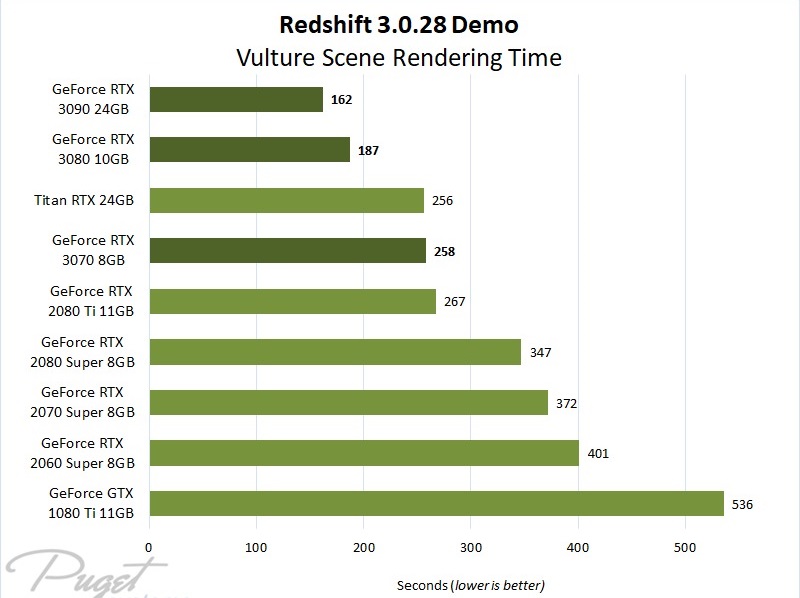
Image Source: pugetsystems.com
In the charts above, here we can see: NVIDIA's RTX 3080 is faster than any RTX 20 Series card was , and almost twice as fast as the RTX 2080 Super for the same price. Combined with a 25% increase in VRAM over the 2080 Super, that increase in rendering speed makes it a fantastic value.
NVIDIA's RTX 3090 is 60% faster than the RTX Titan , which was the top consumer video card from last generation, while costing $1000 less and maintaining the same amount of VRAM. Moreover, the RTX Titan was only available from NVIDIA with their dual-fan cooling solution, meaning it could not be used effectively in multi-GPU configurations . The Founders Edition RTX 3090 that we tested for this article may not be ideal for that either, but Gigabyte has released a blower-style variant of the 3090 which should work in that type of configuration. At 350W of draw per card, though, current power supplies may not be able to run a full set of four.
When comparing these new cards to each other there are many trade-offs to consider. The RTX 3090 is about 15% faster for rendering in Redshift than the 3080 , which is not bad, but considering it also costs more than twice as much that isn't fantastic either. However, the 24GB of VRAM on the RTX 3090 is more than double what the 3080 offers (10GB) and the 3090 is also the only 30 Series card announced so far which supports NVLink. That means it will be much better suited to working with large scenes and detailed geometry.
Conclusion: So for raw price, performance the RTX 3080 wins, but in terms of maximum performance, features, and support for rendering more complex scenes the GeForce RTX 3090 is clearly superior.
Octane Render is a GPU-based renderer that handles processor-heavy algorithms with ease. It's considered one of the fastest real-time render software plugins on the market to date. Making use of its interactive real-time viewport system, it smoothly speeds up your workflow by essentially displaying your final render as you work, edit and place materials, and frame compositions.
An ideal contender for architectural visualization, this rendering software also boasts that along with its comprehensive interface yielding beautiful results fairly quickly, its processing speeds dwarf that of other GPU-based plugins by 10–50 times. In particular, Octane only supports NVIDIA cards . Sadly, AMD Radeon GPUs – no matter how good and how capable they might be – are not supported by the Octane render engine.
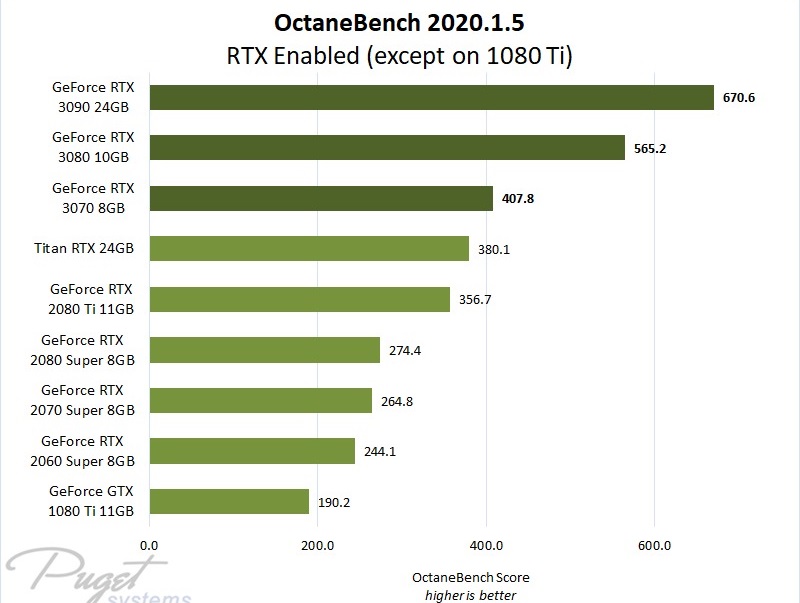
Image Source: pugetsystems.com
- RTX 3070 8GB – This is a solid budget card, for those who are just getting started with GPU rendering or on a limited budget.
- RTX 3080 10GB – This card is more affordable than the 3090 and offers better rendering performance-per-dollar if you consider the card alone. However, its lower amount of VRAM may limit the complexity of scenes you can render and it lacks NVLink support as well. If you aren't working with very complex scenes, though, one or possibly two of these would give great results for their price.
- RTX 3090 24GB – This card is 75% faster than the RTX Titan , which was the top consumer video card from last generation, while costing $1000 less and maintaining the same amount of VRAM. RTX 3090 is about 20% faster for rendering than the 3080, with 140% more onboard memory and support for NVLink. That means it will be much better suited to working with large scenes and detailed geometry. Moreover, Gigabyte has released a dual-slot, single-fan version of this card which should allow multiple GPUs in a single system for increased performance.
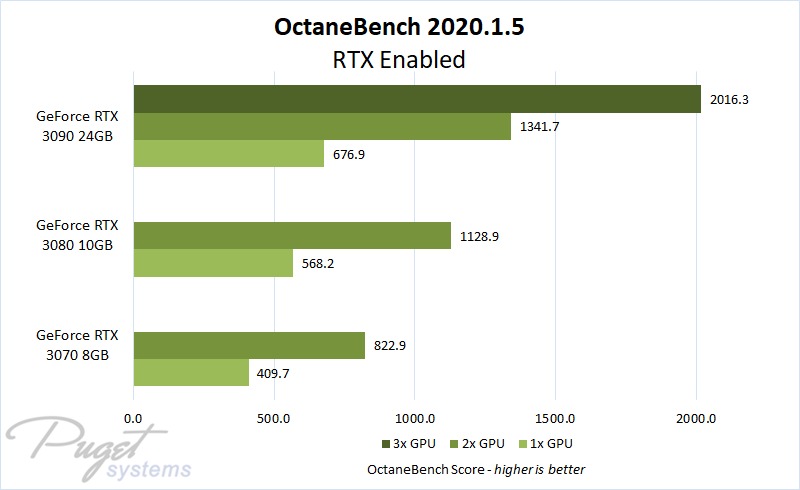
Image Source: pugetsystems.com
Beyond the selection of which card to use is the question of how many. OctaneRender scales very well across multiple video cards, but the cooling systems on most old GeForce models are not designed with multiple GPUs in mind. For the best overall performance, variants with a single fan that exhausts heat out the back (commonly called "blower" cards) are ideal. Stacking a few of those will give fantastic rendering performance, though it does require a larger chassis, strong power supply, and plenty of airflow from the case fans. That's why we recommend the RTX 30 Series, especially for RTX 3090 .
V-Ray is a biased computer-generated imagery rendering software application developed by Bulgarian Chaos Group, which was established in Sofia in 1997. V-Ray is a commercial plug-in for third-party 3D computer graphics software applications and is used for visualizations and computer graphics in industries such as media, entertainment, film and video game production, industrial design, product design and architecture.
However, for V-Ray RT the video card selection is the biggest single factor in rendering speed / performance. RT has a couple of different modes, though not all plugin versions support both. An OpenGL mode exists in some versions for use with AMD graphics cards, but the main focus is on the CUDA mode for NVIDIA cards. (Users using AMD will not get the embree acceleration because that's an NVIDIA bonus)
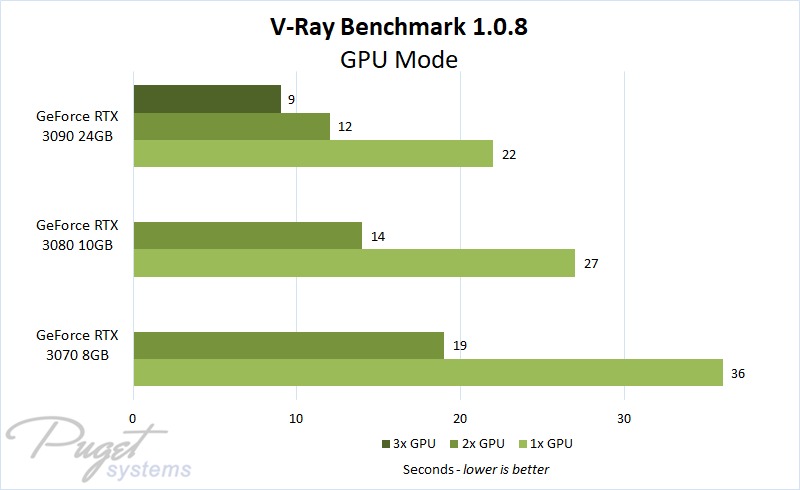
Image Source: pugetsystems.com
Looking beyond raw performance, let's talk about value. In every one of these benchmarks, a pair of GeForce RTX 3070 cards is able to outperform a single RTX 3090. Since those two 3070s would cost $500 less that seems like an appealing option, and for some folks, it may indeed be viable. There are a couple of things to keep in mind with such comparisons, though:
- VRAM – Since the RTX 3070 has only 8GB of onboard memory, compared to the RTX 3090's 24GB, it will be much more limited in terms of scene complexity and texture resolution. Some rendering engines can use system memory for portions of that data, but doing so will usually have a negative impact on performance.
- Upgrade Capacity – If you opt for dual RTX 3070s (or even 3080s) then you can't really upgrade further without taking them out and putting in new cards, while a system with a single RTX 3090 blower card could have one or two more added in the future. GeForce RTX 3090 – Our go-to recommendation for most GPU rendering customers, the RTX 3090 provides the best performance in V-Ray while also having a tremendous 24GB of memory. It is also available with blower-style coolers, enabling use of multiple cards if desired.
As we have seen in the past, GPU rendering scales extremely well across multiple video cards. Both OctaneRender and V-Ray Next have effectively perfect scaling: two cards provide twice the performance of one card, with very slight variations that are within the margin of error. Scaling from a second video card is still respectable – in the range of 83 to 93% improvement.
Developed by Nvidia, Iray is a biased GPU renderer that's one of the best 3D CAD rendering software aimed at beginners, students and hobbyists who don't have expert rendering knowledge, as well as professionals. This intuitive, physically based rendering technology uses AI denoising, CUDA, NVidia OptiX and Material Definition Language (MDL) to generate photorealistic imagery with great speed and efficiency, making it one of the most realistic 3D rendering software.
Supported NVIDIA GPU with Iray drivers: All RTX, GTX, Quadro and TITAN cards from the Turing, Pascal, Maxwell, and Kepler/Fermi generations are technically supported. Render speed is primarily determined by the number of CUDA cores (the more the better) and the GPU's clock speed. Sadly, AMD Radeon GPUs – no matter how good and how capable they might be – are not supported by the Iray render engine.
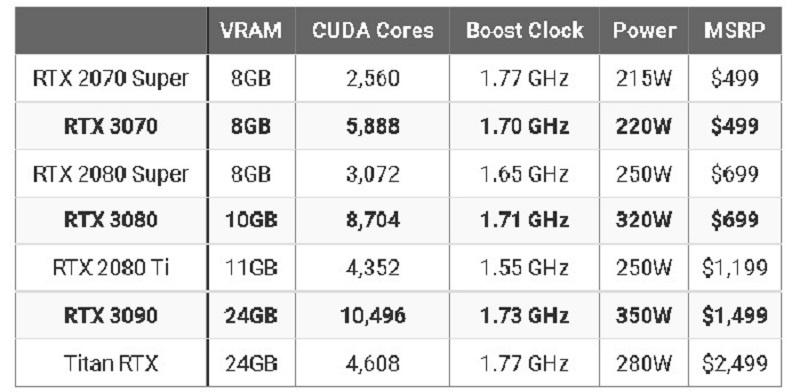
The series of NVIDIA cards goes way back. To keep it simple, I will only focus on the recent few years of usable cards here:
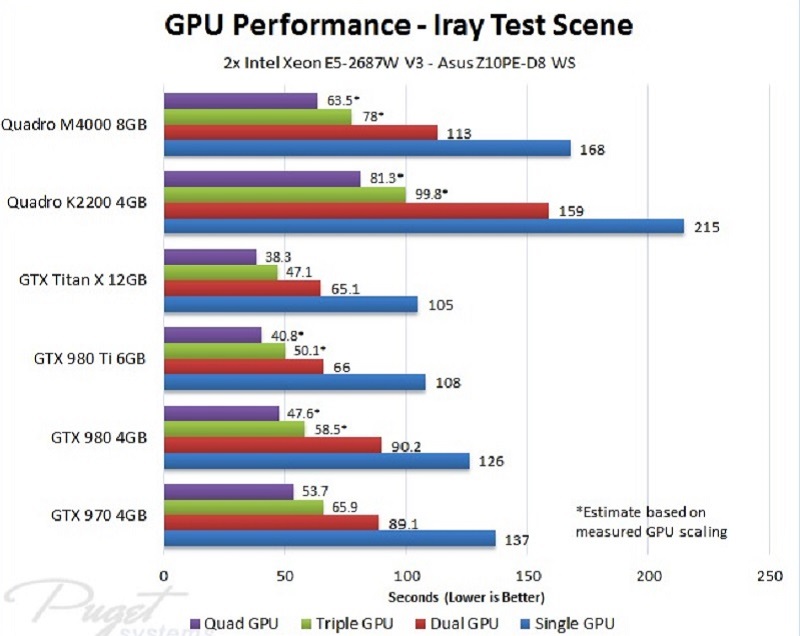
Image Source: pugetsystems.com
In the charts above, the first thing to notice is that there is clearly no advantage to using Quadro over GeForce. In fact, the Quadro M4000 was about 20% slower than the GTX 970 even though the GTX 970 is almost a third the cost. Specifically, some Quadro GPUs offer larger amounts of VRAM but also cost far more for the same level of raw performance of GeForce cards. As such, we recommend the NVIDIA Geforce series if IRAY is your primary application. As of October 2020, these are roughly the upper tier of consumer-level GPUs from fastest to slowest.
- RTX 3060 Ti (4864 CUDA Cores, 8GB VRAM)
- RTX 3070 ( 5888 CUDA Cores, 8GB VRAM)
- RTX 3080 ( 8704 CUDA Cores, 10GB VRAM)
- RTX 3090 ( 10496 CUDA Cores, 24GB VRAM)
Second, when it comes to using multiple GPUs Iray performance scales pretty well . While you don't get twice the performance with two cards compared to just one card, you do get a very nice bump in performance. On average, going from one card to two reduced render times by about 33% (a third). Going from one card to three cards results in about half the render times ( 49% to be exact), and going from one card to four reduces render times by a bit less than two thirds ( 60% ).
Blender makes liberal use of GPU acceleration, which means that a good GPU can have an impact on just about everything you do in Blender. Not all GPUs are alike, however, and there are some important differences you should be aware of before you commit to a particular brand or price point. Blender renders faster and runs smoother on CUDA GPUs for obvious reasons: CUDA is built to be used the way Blender uses it. OpenCL isn't designed to compete with CUDA. Blender's development team is actively working with Nvidia to fully integrate OptiX features into Blender and OptiX accelerated CUDA rendering already is available alongside the existing CUDA and OpenCL implementations.
Blender's heavy use of GPU acceleration and its rock-solid CUDA implementation makes an Nvidia graphics card a safe choice for most users. Non-CUDA cards (for example: AMD cards) aren't the best choice for rendering, but they're still a good choice for users interested in consistent viewport performance. If you navigate your Scene a lot by moving around the camera in Blender or playing back animations, Nvidia GPUs are a solid choice.
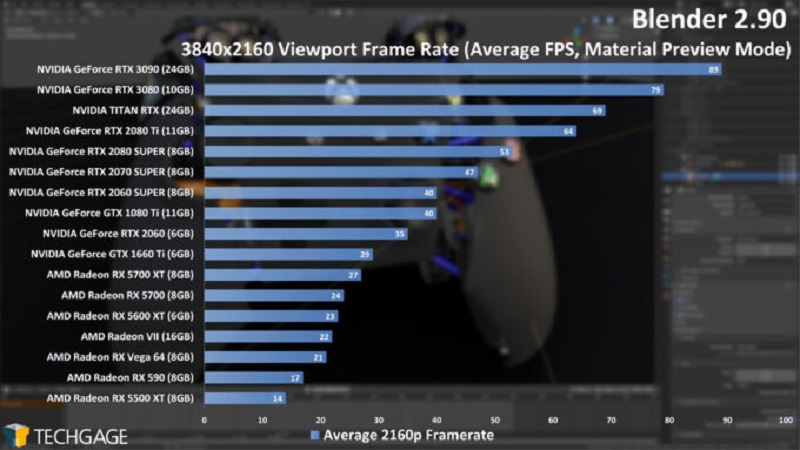
Image Source: techgage.com
When it comes to looking at GPU specifications, pay attention to the number of compute-cores (CUDA or OpenCL, depending on what brand you buy) and the amount of VRAM. Blender is just as hungry for VRAM as it is normal RAM, and a GPU with ample VRAM is worth paying extra for if you're interested in sculpting, high poly modeling, or GPU rendering.
For all the reasons mentioned above, we definitely recommend:
- Performance Pick: Nvidia RTX 3090 or RTX 3080
- Value Recommend: Nvidia RTX 3060 Ti and RTX 3070
- Budget Choice: Nvidia GTX Model
In conclusion, the value of some Quadro GPUs is worse for GPU rendering compared to mainstream or "Gaming" GPUs, even though these "Pro"-level GPUs offer even more VRAM. There are some features such as ECC VRAM, higher Floating Point precision, or official Support and Drivers that make them valuable in the eyes of enterprise, Machine-learning, or CAD users, to name a few. Similarly, RTX Titan was only available from NVIDIA with their dual-fan cooling solution, meaning it could not be used effectively in multi-GPU configurations. For your GPU Rendering needs, stick to mainstream RTX GPUs for the best value, especially the beast RTX 3090.
The bad news is that GPUs are so capable that they are very popular devices used by the crypto mining community, which leads to a significant increase in the price and scarcity of the RTX 30 Series in the market. Investing $1500 for a graphics card, not to mention the costs of compatibilities to build a computer, is also very expensive. This is such a big investment for single individuals or freelancers. However, iRender gives you an affordable answer for all 3D artists to unleash their creativity with the beast RTX 3090 from just 3.8 USD/hour . iRender is a Professional GPU-Acceleration Cloud Rendering Service provider in PC optimization for rendering tasks, CGI, VFX with over 16.000 customers and being appreciated in many global rankings (e.g. CGDirector, Lumion Official, Radarrender, InspirationTuts CAD, All3DP ). This is the only render farm that users can install any software and plugins that serve their project, take full control over the machine and use it as their local computers.
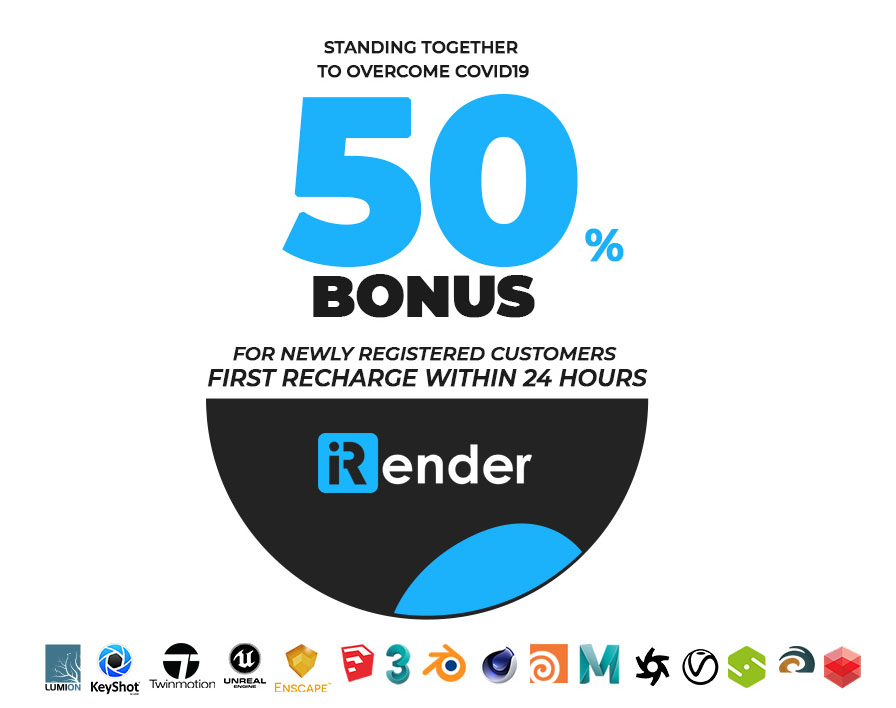
Now go forth and create! Become a member of the iRender community today to stop wasting pointless hours of rendering. Always at the forefront of cutting-edge graphics technology, we do the rendering, the creativity is yours!
iRender – Happy Rendering!
Source: pugetsystems.com
#iray, 3D animation, 3drendering, 3dvisualization, animation, blender, cloud computing, cloud gpu, cloud rendering, Cloud rendering service, cloudrenderfarm, cloudrendering, cloudservice, computer performance, cycles, design, eevee, Gpu Rendering, gpurental, graphicdesign, iRender, Nvidia, Octane, redshift, render, renderer, RenderFarm, RTX3080, RTX3090, vray
Best Gpu For 3d Rendering
Source: https://irendering.net/best-gpu-for-3d-rendering-2021/#:~:text=GeForce%20RTX%203090%20%E2%80%93%20Our%20go,a%20tremendous%2024GB%20of%20memory.
Posted by: stampernernat.blogspot.com

0 Response to "Best Gpu For 3d Rendering"
Post a Comment